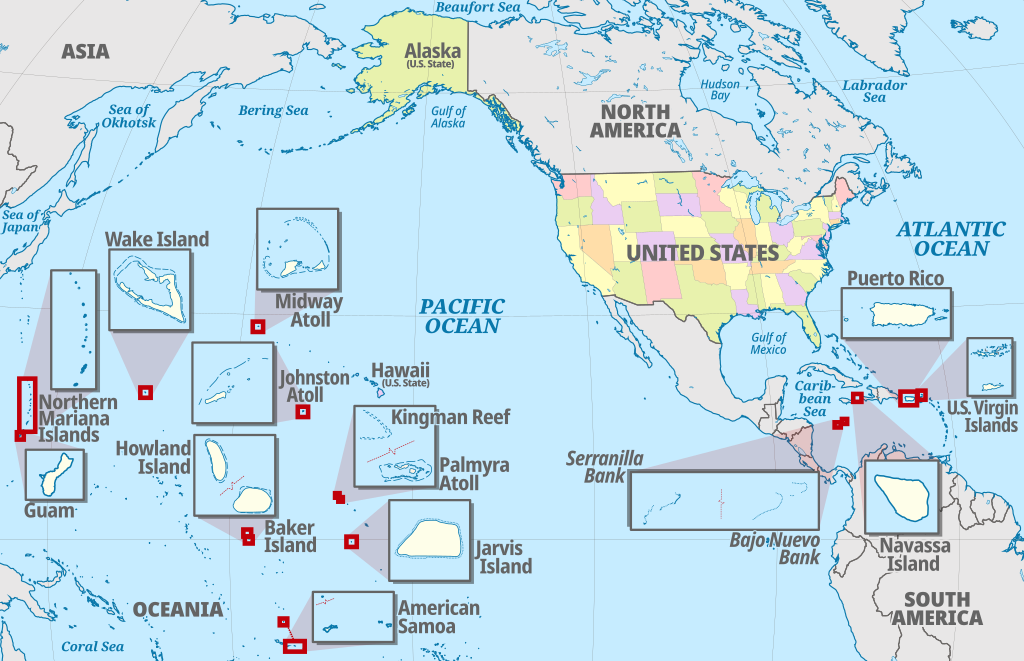Puerto Rico is just one of the five inhabited territories belonging to the United States. These are all the territories:
- Puerto Rico
- U.S. Virgin Islands
- Guam
- Northern Mariana Islands
- American Samoa
People ask us why we fight for statehood only for Puerto Rico and not for the rest of the territories as well. The simplest answer is that we are in Puerto Rico, not in any of the other territories. We believe that they, too, should have self-determination, but we do not try to guess what the people of the other islands want.
We know that Puerto Rico wants a permanent connection with the United States and equal rights under the U.S. Constitution. We know that statehood is the political status that will meet these goals. With a population of roughly 34.2 million, Puerto Rico is the home of about 90% of all the inhabitants of the U.S. territories.
U.S. Virgin Islands
The United States acquired the U.S. Virgin Islands from Denmark for $25,000,000 in 1917. With 105,870 residents, the Virgin Islands meet the traditional requirement of 60,000 people to become a state.
In 1993, they had a referendum asking the people whether they would prefer to remain a territory, become a state, or become an independent nation. About 82% of the voters chose to remain a territory. As in Puerto Rico, just about 5% voted for independence. There has not been another vote on political status.
Guam
Spain ceded Guam to the United States along with Puerto Rico. Guam has 170,534 people. They also have a statehood movement. In January, 1982, they held a referendum with lots of status options. The most popular one, which was separate from the option to continue as a territory, was to become a commonwealth. As we know, “commonwealth” has no legal meaning in U.S. politics. Kentucky is a commonwealth. Puerto Rico is a commonwealth. Guam could call itself a commonwealth but that would not change their political status, as we know from our own experience.
What they really learned from the 1982 referendum is that having lots of options doesn’t work well in a status vote. None of the options gained a majority.
In September of the same year, they held another referendum, this one with the top two choices from the first: commonwealth status and statehood. Voters once again chose commonwealth.
Since “commonwealth” has no meaning in this context, we cannot be surprised that there was no change in Guam’s political status.
Northern Mariana Islands
The Northern Mariana Islands, which used to be U.N. Trust Territories like Palau and the Marshall Islands, have only 49,481 residents. This is traditionally too few for statehood. They voted against independence in the 1970s and became a commonwealth — in other words, they are an unincorporated territory like Puerto Rico.
The Northern Marianas have in the past reached out to Guam to join together to become a state. There was a 1961 referendum on political status. The questions on that status referendum were these:
- [A] Do you desire to become United States citizens within the political framework of Guam?
- [B] Do you desire to become United States citizens by becoming a separate territory of the United States?
- [C] Do you desire to remain in the same status?
- [D] Other Wishes?
65% chose to integrate with Guam, 35% chose to become a separate territory, and 27 voters wanted to remain a U.N. Trust Territory. Zero voters chose independence. Similar results were recorded in 1963 and 1969. Guam voted on the merger in 1969 and the idea lost. Those leaders who still favor the integration of Guam and the Mariana Islands call it the “reunification” of the Mariana Islands.
American Samoa
American Samoa became a U.S. territory in 1899 under a treaty with Germany, with deeds signed by the local leadership following in 1900 and 1904.
American Samoa has just about 45,000 people, fewer than the traditional required number for a state. However, American Samoa does not want statehood. In fact, the majority of Samoans do not even want U.S. citizenship. American Samoans are U.S. nationals, not U.S. citizens. This allows American Samoa to avoid some requirements of the U.S. Constitution which would be incompatible with their traditional way of life.
Individuals from American Samoa can go through the same naturalization process as nationals of any country to become U.S. citizens.
One size does not fit all
While all the inhabited territories of the United States have the same limitations and inequities, their circumstances are not the same. None of the other territories has had a status vote during this century. Puerto Rico, however, has held three. Statehood won each time. Puerto Rico has formally requested admission as a state, and there is a status bill currently under consideration in Congress. It is time — and past time — for Congress to take action on the status of Puerto Rico.
Please ask your congressional reps to get on the right side of history and support statehood for Puerto Rico.








No responses yet